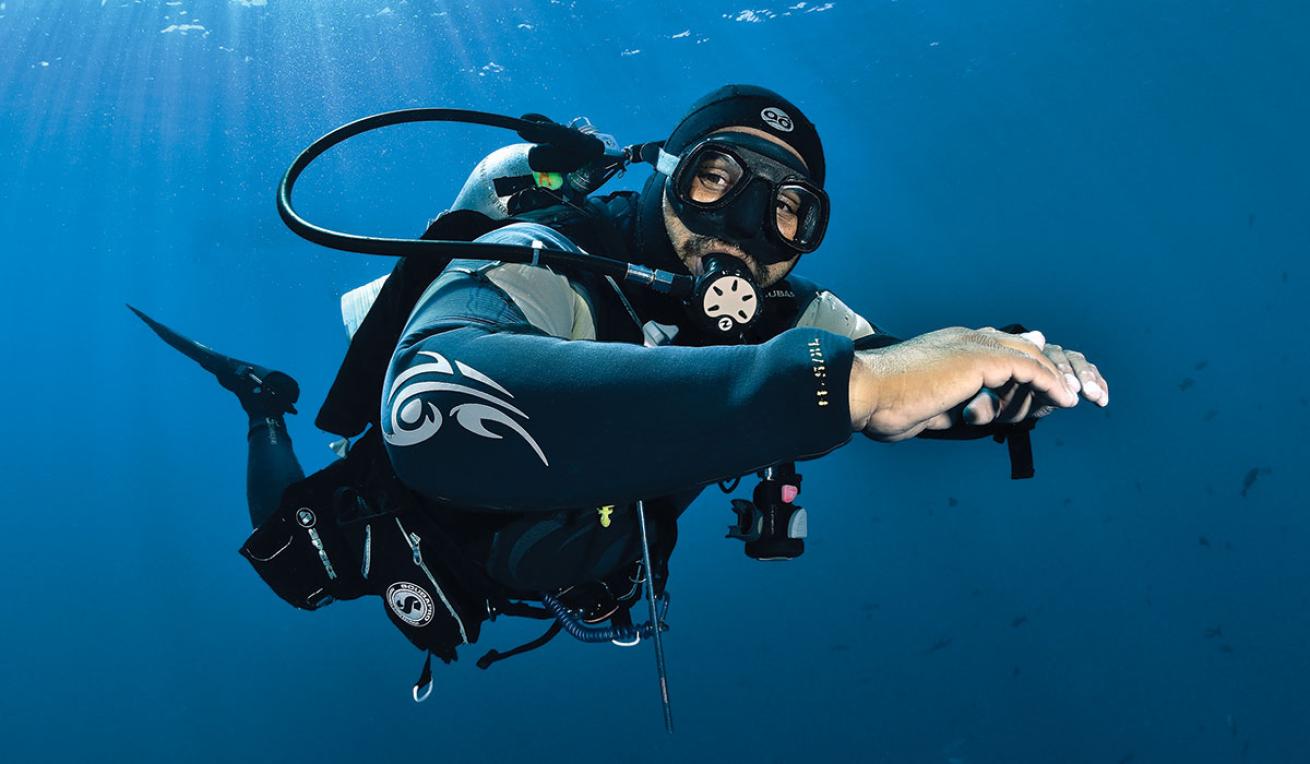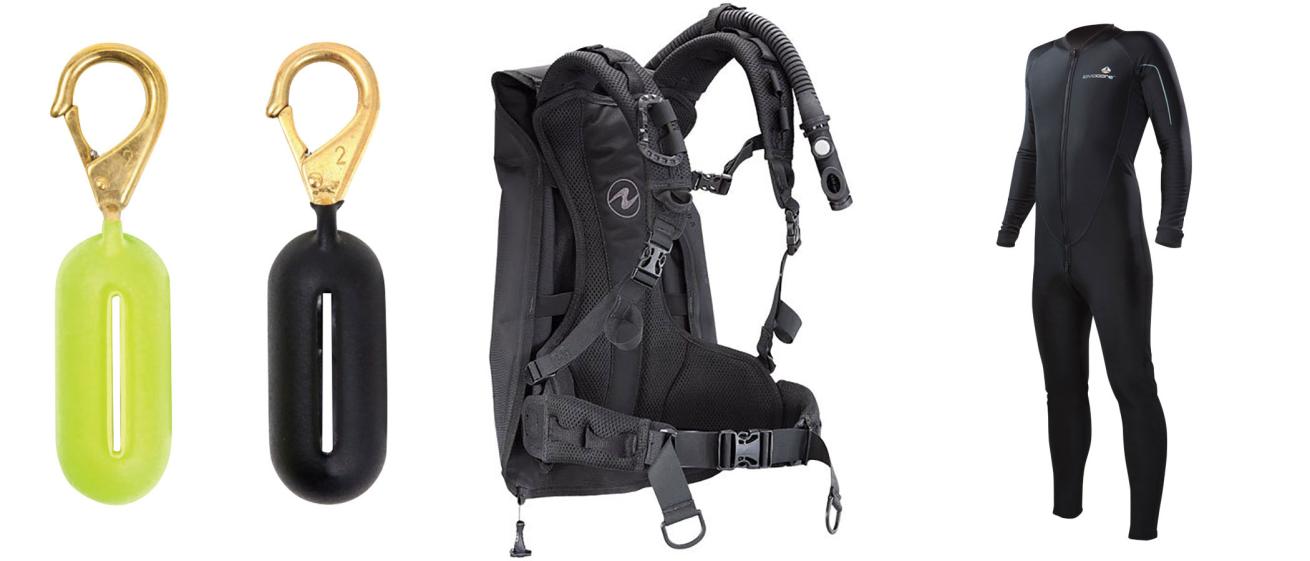Tips for Using Less Weight While Scuba Diving

Damien MauricHow to shed the pounds and get to your ideal diving weight.
Let’s talk about your weight problem. When you first learned to dive, you were probably loaded down with too much weight and simply didn’t know any better. When you had trouble descending, you added a couple of pounds of lead. When you started to sink at depth, you blasted a quick shot of air into your BC and swam on, unaware that your imprecise balance of ballast and buoyancy was holding you back from true underwater bliss. On the dive boat, you watched as more-experienced divers loaded minimal weights into their pockets while you scrambled to find extra lead to get the job done.
Or so you thought.
“It’s important to dive with optimal weight so you can easily adjust for buoyancy changes with depth — the more gas required to offset negative buoyancy, the more dramatic the effects of compression and expansion in the diver’s buoyancy compensator,” says Lauren Kieren, owner of Kieren Technical, a technical, cave and rebreather instruction company in High Springs, Florida. “In addition, diving with optimal weight is key to moving efficiently through the water, easily managing descents and ascents, reducing impacts to the environment by either touching the bottom or having excessive propulsion wash hit the bottom, and, of course, having a more enjoyable experience.”
“Overweighted divers risk exceeding the ability of their BC or wing to maintain positive buoyancy while on the surface or neutral buoyancy while on their dive,” says Tom “T.J.” Johnson, instructor and owner of Dayo Scuba Center in Winter Park, Florida. “Getting yourself weighted properly helps you conserve gas,” says Patrick Hammer, owner and training director at Scuba Emporium in Orland Park, Illinois, “and makes you ultimately more comfortable underwater.”
Fine-tuning the amount of ballast needed to counterbalance the inherent buoyancy of your body and your equipment is one of the most common and frustrating challenges for any diver. But once you get your optimal weight dialed in, you’ll discover a world of difference in both your performance and enjoyment. Consider these tips from our experts in your quest to get down to your ultimate diving weight.
Know when enough is enough
There are many physical indicators that you’re carrying too much weight. The key is to be honest and thoughtful about what you’re experiencing and taking the right steps to fix it.
“When you’re too heavy, you drop fast, burn gas fast and get tired fast,” says Hammer, who has been a PADI course director for 43 years. “When you can hover with ease and glide through the water, you know you’re weighted properly.”
“If you are working hard to keep up with your buddy, it’s possible you are not weighted correctly,” says Kieren, a passionate cave diver and technical, CCR, and instructor trainer. “A few other specific things to look for include your overall body positioning in the water; divers who are overweighted will typically swim slightly heads-up and fin tips down since they are constantly fighting the negative buoyancy. Divers who are underweighted will swim with their head down and feet elevated, fighting the positive buoyancy by constantly swimming down slightly to move forward. Take notice of what your fins are doing. When you stop moving your feet, if you immediately sink, you’re likely overweighted or do not have appropriate gas in your BC to maintain neutral buoyancy. On the contrary, if you rise, you’re likely kicking to stay down or have too much gas in your BC.”
Seek professional help
One of the best ways to identify your weighting problems is to ask your favorite local instructor or even the pro on your next dive trip for an intervention. Trained eyes can spot issues and provide solutions.
“A dive professional has the experience to notice subtle cues to determine how to adjust a student’s weighting,” Kieren says. “Working with an instructor and focusing solely on buoyancy and weighting for a few dives is usually the most efficient way to get yourself dialed in.”
“It helps quite a bit for anyone who knows what trim and buoyancy are to look at and assist you while working on weighting,” says Johnson, who teaches divers from open water through tec, cave and instructor. “A diver’s attitude (angle in the water) might not be horizontal (the preferred posture), but they might think so. Taking pictures of the diver helps as well.”
“I like to use clip-on weights with my students,” Hammer says. “I have the diver with 1,000 pounds of gas or less do a surface weight check, then at depth I see if they can be neutral with ease, and if needed, I add clip-on weights until I see how much they need to become neutral.”

Sea Pearls; Aqua Lung; Lavacore
Sea Pearls Quick-Attack 2-Pound Weights Aqua Lung Rogue Lavacore Front-Zip Polytherm Fullsuit $25; seapearls.com $579; aqualung.com $220; lavacoreinternational.com Clip these handy bullet weights to your BC to fine-tune your ballast in a safe and convenient way. The vinyl coating is chemically bonded to the lead for increased durability. The Rogue has only a half-pound of inherent buoyancy, so it’s a great choice for divers trying to decrease their load. The smart modular system empowers divers to fully customize their rig. It’s technically a fabric, but it works like neoprene — but without the inherent buoyancy. The flexible laminate also can layer under a wetsuit.
Factor in your gear
With buoyant bones, fat cells and air pockets, your body is the strongest influence on your ballast needs, but your equipment can also add significant challenges to dropping weight. Besides your exposure suit — the most obvious culprit — your BC might be your biggest contributing problem.
“The type of BC is the foremost item for consideration,” says Johnson. “You want one that’s got integrated weights and weight pockets. Weight belts might work to get good buoyancy but might mess up your trim.”
“BCs with appropriate lift capacity are essential,” Kieren says. “We often see divers wearing BCs with air cells that are far too big, which allows gas to get trapped. Instead of managing the airspace by removing the excess gas, the tendency is to add more weight, which simply makes the problem worse. The gas can also become trapped while ascending, creating a hazardous uncontrolled ascent. A streamlined back plate and wing systems with appropriately sized air cells will help divers avoid many of these issues, and also place gas in the most effective positions to create a much more stable platform.”
Work it out — and take it off
With your problems diagnosed, solutions can be established easily, but you won’t start to see results without trial and error.
“One of the most efficient ways to determine how much weight you need is to find a shallow body of water or pool to perform a weight check, alongside a dive professional or qualified teammate,” says Kieren. “To do this, use a tank with around 500 to 800 psi remaining, don your complete scuba system and thermal protection, let all of the gas out of your BC, and try to hold position around 10 feet. Add or remove some weight until you are perfectly neutral while breathing naturally. This method will help you determine optimal weighting with the cylinders you are using (either steel or aluminum).”
“Keep in mind that the weight you finish with is good for only that type of water — fresh or salt,” Johnson says, “as well as the type and thickness of exposure protection you use — wetsuit, drysuit, et cetera.”
And don’t forget that as you progress through your training to tackle new environments, change equipment, or experience weight loss or gain, you’ll be continually adjusting your ballast weight to maintain optimal buoyancy. Fortunately, all this fine-tuning means you’ll be underwater.










